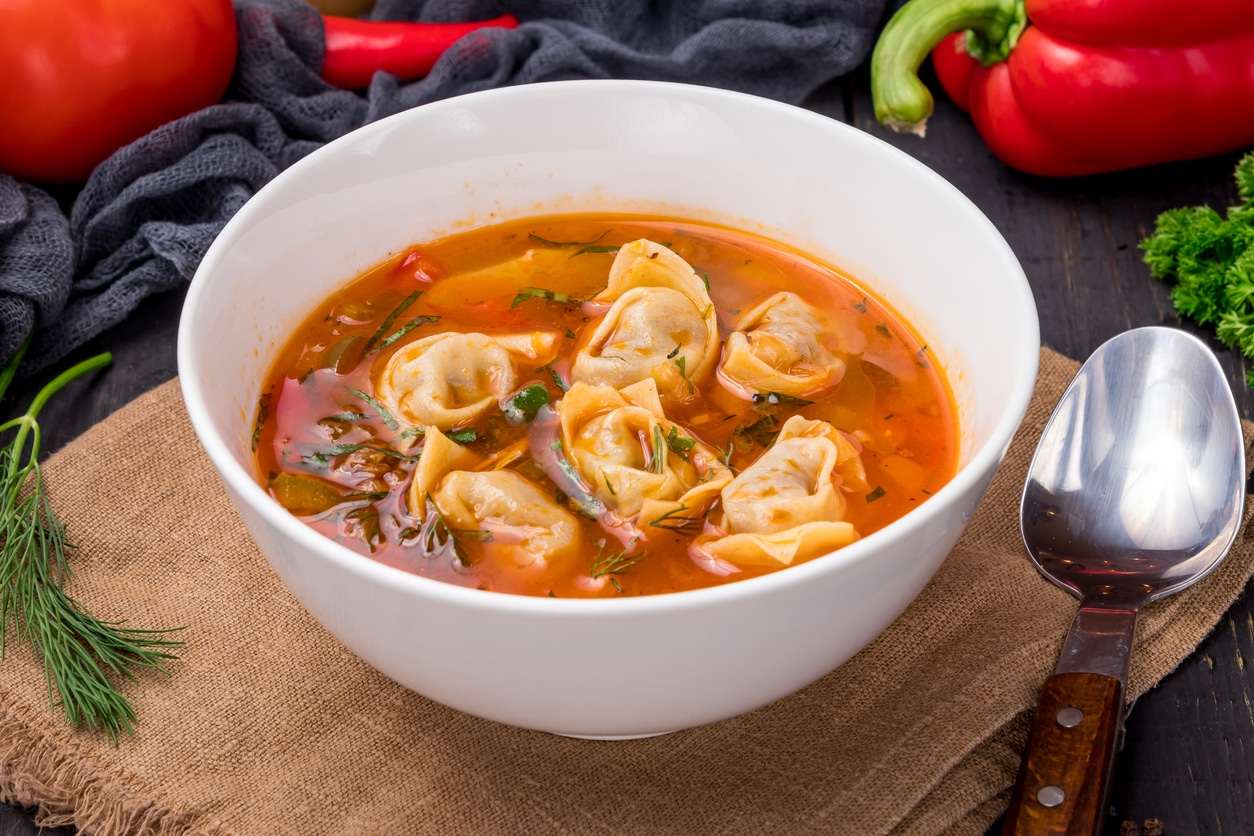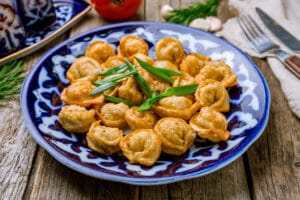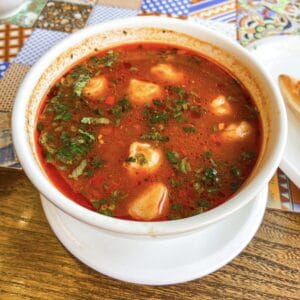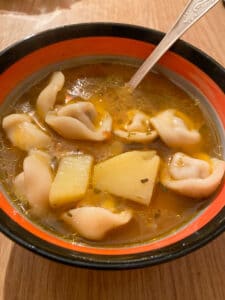Chuchvara is a dumping staple dish in Central Asia, the South Caucasus, and the Middle East. Originally introduced there under the Persian Empire, they are today most associated in Central Asia with Uzbek tradition. However, they are also considered a local national dish throughout the countries of the region.
Chuchvara contrast with manti, the other local dumpling. Chuchvara are ear-shaped, smaller and usually either part of a soup or fried. Manti are bag-shaped, larger and usually steamed.
How Chuchvara Got Its Name
(Почему так называется?)
Chuchvara was originally “joshpara.” In pre-Islamic Persian, josh means “to boil” and para means “bit.” However, after the 10th century, people began to refer to the dumpling with the modern Persian word “goshebarreh,” which is phonetically similar but actually means “lambs’ ear” and referred to the folded shape of the dumpling.
As the food became popular with Turkic speakers, who eventually displaced Persian speakers in most of the Central Asia, the name was further changed to better suit Turkic languages. In addition, the former meanings were lost and today the Turkic words simply refer to the dumping.
In modern Uzbek, they are chuchvara. In Krygyz, they are chuchpara, in Kazakh, tushpara, and in Azeri, “dushbara,” (sometimes written “dushbere”). The dish is also eaten by the Ughirs (who call it “chochura”) in Western China.
They are still eaten throughout the Persian-speaking world as well. In Iran, it is still known as “goshebarreh” while in Tajikistan, which speaks a Persian language, it is known by the more Turkish-sounding “tushbera.”
In Arabic speaking countries where the succulent dumplings are eaten, they are known as “shishbarak.”
How and When Chuchvara is Eaten
(Как правильно есть чучвару?)
There are two main ways to eat chuchvara. They are most often eaten as a hearty dumpling soup stewed with meat and vegetables. There are also fried chuchvara, which are eaten as finger food.
In Kyrgyzstan, for instance, chuchpara soup is eaten at home for lunch or dinner as a staple main dish. However, if you order chuchpara in a Kyrgyz restaurant or café, it is served in smaller portions as a starter to the main meal.
Fried chuchvara is more celebratory and is often served at weddings, parties, and large family gatherings as an appetizer. They are eaten with the hands, usually with a sour cream or yogurt dipping sauce.
Chuchvara is also sometimes cooked by simply steaming or boiling the dumplings and serving with fresh, chopped greens, yogurt, and/or sour cream.
Preparing Traditional Chuchvara
(Как правильно готовить чучвару?)
Traditionally, chuchvara is made with ground lamb and/or beef, but you are more than welcome to use chicken as a substitute. In observance of Islamic dietary rules prevalent in Central Asia, pork is never used in chuchvara.
Any many countries, such as Uzbekistan, the most traditional chuchvara will start with dough cut in squares. This will result in a dumpling with more folds and one that will look, indeed, much more like a lamb’s ear. However, many recipes, particularly those in Kyrgyzstan, will start with round dough cuts, which results in a more compact dumping and one that looks, generally, very much like Russian pelmeni, said to look more like a human ear. In between, there are also different ways of folding both shapes that will give the dumpling a different appearance and texture.
Chuchvara can be a time-consuming recipe. They are sometimes made as large as a 50-cent piece, common in Kyrgyzstan, or as small as a dime, which is common in Azerbaijan. Thus, folding the dozens of dumplings that might be needed to feed a large family may take multiple hours. However, nowadays you can buy frozen chuchvara dumplings at nearly any supermarket or bazaar in Central Asia. This is a great option if you are low on time or ambition. If you do make the chuchvara dumplings by hand, you do not have to cook them all at once, you can freeze any amount you like, and they will stay good in the freezer for up to three months.
Depending on the cook and personal tastes, chuchvara soup is often topped with fresh dill, sour cream, and green onions. Some cooks also add radishes and bell peppers to the soup; however, this is not common.
Let’s Cook Chuchvara!
(Давай приготовим!)
| Чучпара (суп) | Chuchpara (Soup) |
| Ингредиенты:
Тесто
Заполнение
Бульон
Дополнительные начинки
Направления на русском языке
Начните с приготовления теста: 1. Налейте в миску чашку (холодной или чуть теплой) воды. 2. Разбейте оба яйца в воду. 3. Насыпьте в миску примерно 3 щепотки соли. 4. Хорошо взбивайте, пока яйцо и соль не смешаются с водой. 5. Медленно добавляйте достаточное количество муки, чтобы получилось мягкое тесто. Тесто станет тугим, и вы сможете скатать его в шар. 6. Накройте тесто кухонным полотенцем или салфеткой и оставьте на столе на 30 минут.
Пока ваше тесто отдыхает, займитесь начинкой. 1. Лук мелко нарезать. 2. Мелко нарежьте свежий укроп. 3. Фарш из баранины или говядины посолить и поперчить и смешать с нарезанным луком и свежим укропом.
По истечении 30 минут для отдыха теста приступайте к формированию теста: 1. Возьмите тесто, разделите его на 3 части одинакового размера. Сформируйте из теста круглые шарики и заверните два шарика кухонным полотенцем или салфеткой, чтобы они не высохли. 2. Посыпьте поверхность и скалку мукой (чтобы тесто не прилипало). Возьмите один из шариков теста и аккуратно раскатайте его в большой тонкий кусок. 3. Вырежьте маленькие кружочки для пельменей, примерно 1,5-2 сантиметра каждый. Вы можете использовать любой предмет, который у вас есть, например, пластиковый стаканчик или консервы. 4. Выложите начинку размером от 0,5 до 1 дюйма в каждый круг теста. 5. Сложите начинку, закрыв ее на себя. Надавите вниз, склеивая два края вместе и создавая небольшую выпуклость там, где должна быть начинка. Соедините два уголка и защипните. 6. Повторяйте инструкции для пунктов 1-5, пока не будет использовано все тесто.
После того, как все пельмени будут раскатаны, нарезаны и заполнены, накройте их кухонным полотенцем или салфеткой, пока они не будут готовы к употреблению.
приготовление бульона 1. Нарежьте лук кубиками. 2. Картофель нарезать мелкими кубиками. 3. Нарежьте помидор (если используете). 4. Нарежьте морковь мелкими кубиками. 5. В большую кастрюлю налейте достаточно масла, чтобы оно слегка покрывало поверхность сковороды. 6. Обжарить мясо на кости, обжаривая каждую сторону. 7. Добавьте нарезанный кубиками лук и морковь, готовьте, пока они не станут слегка мягкими. 8. Добавьте нарезанный кубиками картофель. 9. Добавьте нарезанные кубиками помидоры или томатную пасту. 10. Посолить и поперчить по вкусу. 11. Добавьте воды, чтобы покрыть (около 4-6 чашек, в зависимости от размера кастрюли). 12. Дать покипеть на медленном огне от 45 минут до 1 часа. 13. После того, как бульон приготовится, примерно от 45 минут до 1 часа, добавьте чучвару и варите еще 12-15 минут (пока мясо внутри чучвары не будет полностью приготовлено и не нагреется до 160 градусов по Фаренгейту). 14. Перелейте суп в миску и посыпьте нарезанным зеленым луком, свежим укропом и сметаной по желанию. |
Ingredients:
Dough
Filling
Broth
Optional Toppings (to taste)
Directions in English
Start by making your dough: 1. Pour a cup of (cold or lukewarm) water into a bowl. 2. Crack both eggs into the water. 3. Sprinkle about 3 pinches of salt into the bowl. 4. Whisk well until the egg and salt have been mixed into the water. 5. Slowly add enough flour to make a soft dough. The dough will become tight, and you will be able to roll it into a ball. 6. Cover the dough with a tea towel or saran wrap and let rest on the counter for 30 minutes.
While your dough is resting, make the filling. 1. Finely chop the onions. 2. Finely chop the fresh dill. 3. Salt and pepper the minced lamb or beef and mix with the chopped onion and fresh dill.
Once the dough has rested for 30 minutes, begin forming the dough: 1. Take the dough and split it into three equal sized pieces. Shape the dough into round balls and wrap two balls back with a tea towel or saran wrap, so they do not dry out. 2. Sprinkle flour on your surface and your rolling pin (to prevent the dough from sticking). Take one of the dough balls and gently roll it out into a large thin piece. 3. Cut out small circles for the dumplings, about 1.5-2 inches each. You can use any object you have, such as a plastic cup, or a can. 4. Drop a .5 to 1 inch filling into each circle of dough. 5. Fold over the filling by closing it towards you. Push down, sticking the two edges together and creating a small bump where the filling is. Bring the two corners together and pinch. 6. Repeat instructions for number 1-5, until all dough has been used.
Once all dumplings have been rolled, cut, and filled, cover them with a tea towel or saran wrap until ready to use.
Now make the broth: 1. Dice onions. 2. Dice potatoes into small cubes. 3. Dice a tomato (if using). 4. Dice carrots into small cubes. 5. In a large pot, pour enough oil so it slightly covers the cooking surface of the pan. 6. Fry the meat on the bone, making sure to sear each side. 7. Add diced onions and carrots, cooking until slightly tender. 8. Add diced potatoes. 9. Add diced tomatoes, or tomato paste. 10. Add salt and pepper to taste. 11. Add water to cover (about 4-6 cups, depending on pot size) 12. Let simmer on low for 45 minutes to 1 hour. 13. Once broth has finished cooking, about 45 minutes to 1 hour, add in the chuchvara and cook for an additional 12-15 minutes (until meat inside chuchvara is completely cooked and at 160 degrees F) 14. Scoop soup into a bowl and top with chopped green onions, fresh dill, and sour cream, if desired. |
| Чучпара (Жареная) | Chuchpara (Fried) |
Ингредиенты:
Тесто
Заполнение
Направления на русском языке Начните с приготовления теста: 1. Налейте в миску чашку (холодной или чуть теплой) воды. 2. Разбейте оба яйца в воду. 3. Насыпьте в миску примерно 3 щепотки соли. 4. Хорошо взбивайте, пока яйцо и соль не смешаются с водой. 5. Медленно добавляйте достаточное количество муки, чтобы получилось мягкое тесто. Тесто станет тугим, и вы сможете скатать его в шар. 6. Накройте тесто кухонным полотенцем или салфеткой и оставьте на столе на 30 минут.
Пока ваше тесто отдыхает, займитесь начинкой. 1. Лук мелко нарезать. 2. Мелко нарежьте свежий укроп. 3. Фарш из баранины или говядины посолить и поперчить и смешать с нарезанным луком и свежим укропом.
По истечении 30 минут для отдыха теста приступайте к формированию теста: 1. Возьмите тесто, разделите его на 3 части одинакового размера. Сформируйте из теста круглые шарики и заверните два шарика кухонным полотенцем или салфеткой, чтобы они не высохли. 2. Посыпьте поверхность и скалку мукой (чтобы тесто не прилипало). Возьмите один из шариков теста и аккуратно раскатайте его в большой тонкий кусок. 3. Вырежьте маленькие кружочки для пельменей, примерно 1,5-2 сантиметра каждый. Вы можете использовать любой предмет, который у вас есть, например, пластиковый стаканчик или консервы. 4. Выложите начинку размером от 0,5 до 1 дюйма в каждый круг теста. 5. Сложите начинку, закрыв ее на себя. Надавите вниз, склеивая два края вместе и создавая небольшую выпуклость там, где должна быть начинка. Соедините два уголка и защипните. 6. Повторяйте инструкции для пунктов 1-5, пока не будет использовано все тесто.
После того, как все пельмени будут раскатаны, нарезаны и заполнены, накройте их кухонным полотенцем или салфеткой, пока они не будут готовы к употреблению.
Жарка пельменей 1. Разогрейте 1 литр масла в глубокой сковороде или кастрюле. 2. После того, как масло нагреется, положите в кастрюлю или кастрюлю от 15 до 20 чучпара за раз. 3. Жарьте, пока они не станут золотисто-коричневого цвета, а внутренняя температура не достигнет 160 градусов по Фаренгейту. 4. Подавать со сметаной для макания (по желанию) |
Ingredients:
Dough
Filling
Directions in English Start by making your dough: 7. Pour a cup of (cold or lukewarm) water into a bowl. 8. Crack both eggs into the water. 9. Sprinkle about 3 pinches of salt into the bowl. 10. Whisk well until the egg and salt have been mixed into the water. 11. Slowly add enough flour to make a soft dough. The dough will become tight, and you will be able to roll it into a ball. 12. Cover the dough with a tea towel or saran wrap and let rest on the counter for 30 minutes.
While your dough is resting, make the filling. 4. Finely chop the onions. 5. Finely chop the fresh dill. 6. Salt and pepper the minced lamb or beef and mix with the chopped onion and fresh dill.
Once the dough has rested for 30 minutes, begin forming the dough: 1. Take the dough and split it into three equal sized pieces. Shape the dough into round balls and wrap two balls back with a tea towel or saran wrap, so they do not dry out. 2. Sprinkle flour on your surface and your rolling pin (to prevent the dough from sticking). Take one of the dough balls and gently roll it out into a large thin piece. 3. Cut out small circles for the dumplings, about 1.5-2 inches each. You can use any object you have, such as a plastic cup, or a can. 4. Drop a .5 to 1 inch filling into each circle of dough. 5. Fold over the filling by closing it towards you. Push down, sticking the two edges together and creating a small bump where the filling is. Bring the two corners together and pinch. 6. Repeat instructions for number 1-5, until all dough has been used.
Once all dumplings have been rolled, cut, and filled, cover them with a tea towel or saran wrap until ready to use.
Frying the Dumplings 1. Heat 1 liter of oil in a deep frying pan or pot. 2. After oil is hot, place 15 to 20 chuchparas in pan or pot at a time. 3. Fry until they are golden brown in color and internal temperature reaches 160 degrees Fahrenheit. 4. Serve with sour cream for dipping (optional) |
Our Favorite Chuchvara Videos
This video is a clear and very simple, step by step way to make Uzbek Chuchvara from an at-home Uzbek chef who now resides in Finland.
https://youtu.be/co1KiN18eoI
This video is hosted by a family who loves to cook! This video is a modern way to make dushbere, with step-by-step directions on how to make dushpere both as a soup and as a fried dish.
You Might Also Like
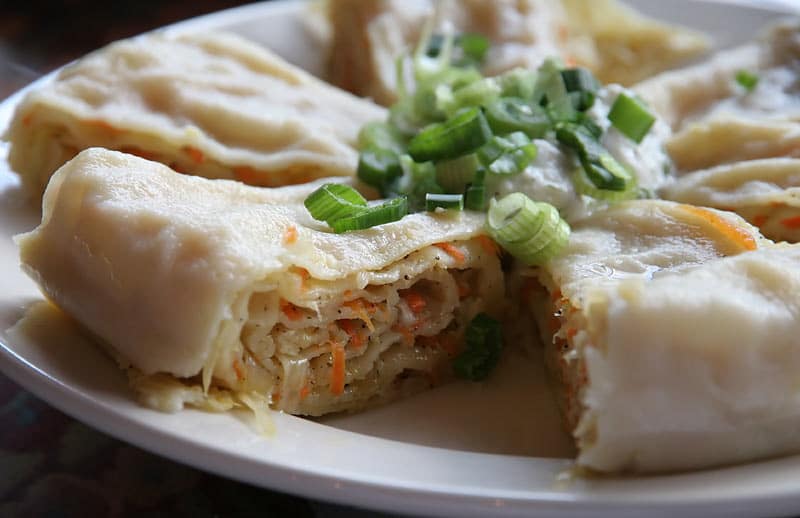
Oromo, Orama, Khanum: A Turkic Pumpkin Delight
For those obsessed with all things pumpkin — pumpkin pie, pumpkin ice-cream, pumpkin-spice lattes — oromo (оромо) is sure to please. Oromo is a rolled, layered, steamed pastry that comes with various fillings (pumpkin being common and our favorite). It evokes everything we love about pumpkin season back home in the States. This main dish […]

Knots of Culture: Central Asia’s Carpet Weaving Heritage
Central Asia’s rich tradition of carpet weaving reflects the region’s history, culture, and identity. From the ancient nomads of the Pazyryk Valley to the artisans of Kyrgyz yurts and the urban weavers of Samarkand, carpets have long served both practical and symbolic functions. Their materials, techniques, and motifs reflect centuries of interaction between nomadic and […]

The Talking Kyrgyz Phrasebook
The Talking Phrasebook Series presents useful phrases and words in side-by-side translation and with audio files specifically geared to help students work on listening skills and pronunciation. Below, you will find several useful phrases and words. To the left is the English and to the above right is an English transliteration of the Kyrgyz translation. […]
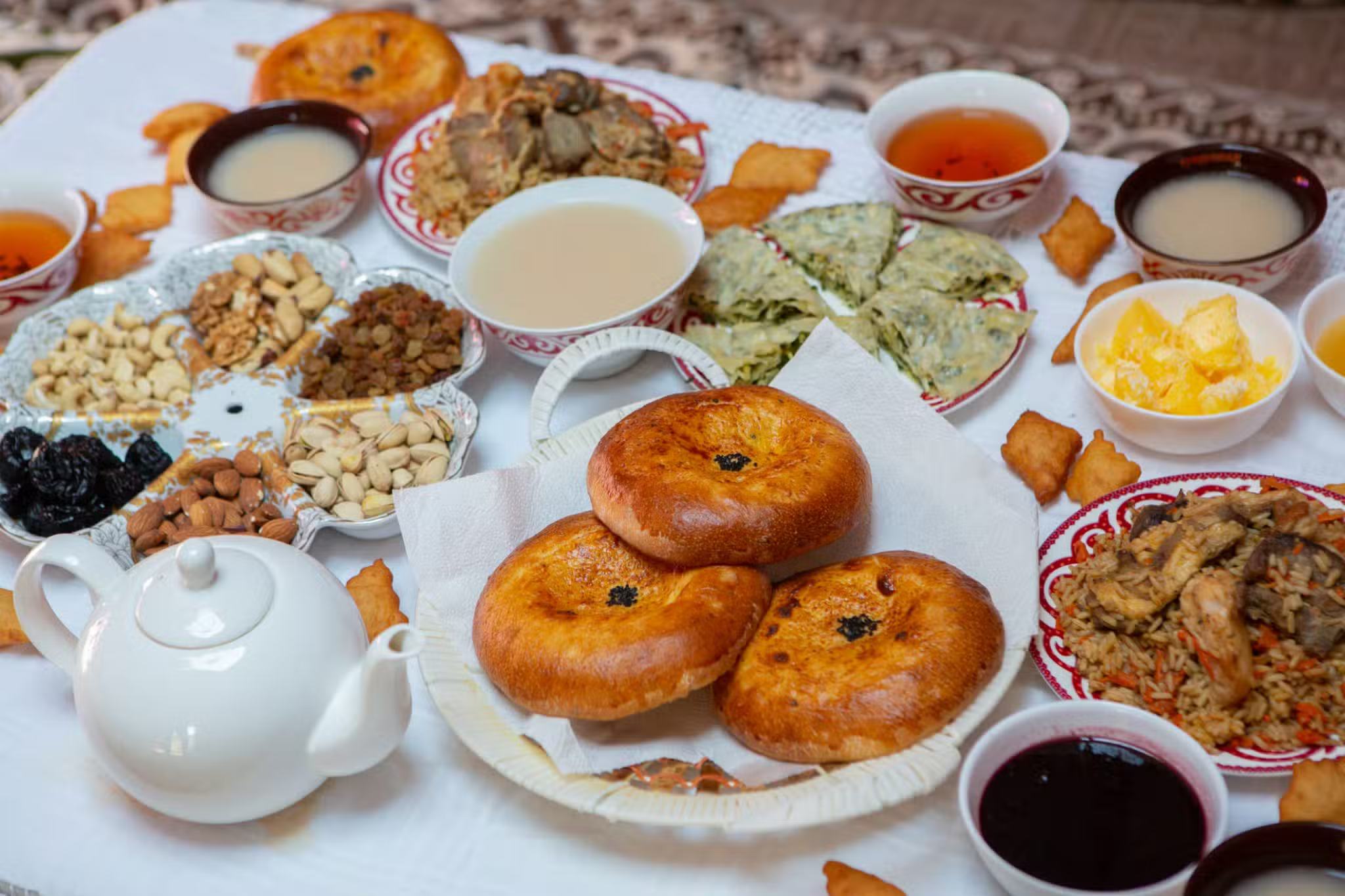
The Kyrgyz Food Dictionary
Kyrgyz cuisine reflects the country’s heritage of pastoral nomadism. Life was spent moving livestock from pasture to pasture and living in collapsible, transportable yurts. The livestock themselves were the primary, sustainable food source. Everything else was either gathered from the land or traded for. The Kyrgyz did not engage in intensive settled agriculture until forced […]

Manas and the Manaschi: Foundations of the Kyrgyz Soul
There are few essential things to know about Kyrgyzstan. One of these is the country’s folkloric hero, Manas. You’ll find nearly everything in Krygyzstan is named after him: the main airport, national parks, major streets in nearly every city and town, and even karate clubs and movie theaters, not to mention the statues of him […]

